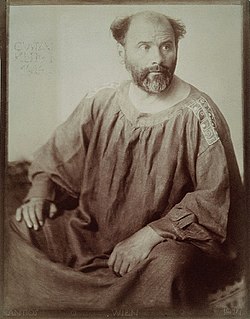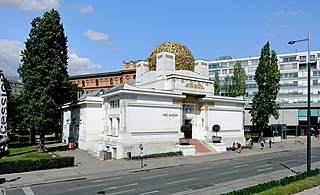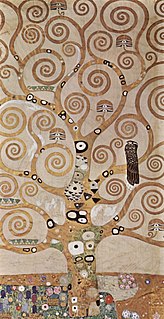
Gustav Klimt was an Austrian symbolist painter and one of the most prominent members of the Vienna Secession movement. Klimt is noted for his paintings, murals, sketches, and other objects d'art. Klimt's primary subject was the female body, and his works are marked by a frank eroticism. Amongst his figurative works, which include allegories and portraits, he painted landscapes. Among the artists of the Vienna Secession, Klimt was the most influenced by Japanese art and its methods.

Art Nouveau is an international style of art, architecture, and applied art, especially the decorative arts, known in different languages by different names: Jugendstil in German, Stile Liberty in Italian, Modernisme català in Catalan, etc. In English it is also known as the Modern Style. The style was most popular between 1890 and 1910. It was a reaction against the academic art, eclecticism and historicism of 19th century architecture and decoration. It was often inspired by natural forms such as the sinuous curves of plants and flowers. Other characteristics of Art Nouveau were a sense of dynamism and movement, often given by asymmetry or whiplash lines, and the use of modern materials, particularly iron, glass, ceramics and later concrete, to create unusual forms and larger open spaces.

The Vienna Secession is an art movement, closely related to Art Nouveau, that was formed in 1897 by a group of Austrian painters, graphic artists, sculptors and architects, including Josef Hoffman, Koloman Moser, Otto Wagner, and Gustav Klimt. They resigned from the Association of Austrian Artists in protest against its support for more traditional artistic styles. Their most influential architectural work was the Secession Building designed by Joseph Maria Olbrich as a venue for expositions of the group. Their official magazine was called Ver Sacrum which published highly stylised and influential works of graphic art. In 1905 the group itself split, when some of the most prominent members, including Klimt, Wagner and Hoffmann, resigned in a dispute over priorities, but it continued to function, and still functions today, from its headquarters in the Secession Building.

The Stoclet Palace is a mansion in Brussels, Belgium. It was designed by Austrian architect Josef Hoffmann for Belgian financier Adolphe Stoclet. Built between 1905 and 1911 in the Vienna Secession style, it is located on Avenue de Tervueren in the Woluwe-Saint-Pierre municipality of Brussels. Considered Hoffman's masterpiece, the residence is one of the most refined and luxurious private houses of the twentieth century.

The Kiss is an oil-on-canvas painting with added gold leaf, silver and platinum. by the Austrian Symbolist painter Gustav Klimt. It was painted at some point in 1907 and 1908, during the height of what scholars call his "Golden Period". It was exhibited in 1908 under the title Liebespaar as stated in the catalogue of the exhibition. The painting depicts a couple embracing each other, their bodies entwined in elaborate beautiful robes decorated in a style influenced by the contemporary Art Nouveau style and the organic forms of the earlier Arts and Crafts movement. The painting now hangs in the Österreichische Galerie Belvedere museum in the Belvedere, Vienna, and is considered a masterpiece of Vienna Secession and Klimt's most popular work.

Portrait of Adele Bloch-Bauer I is a painting by Gustav Klimt, completed between 1903 and 1907. The portrait was commissioned by the sitter's husband, Ferdinand Bloch-Bauer, a Jewish banker and sugar producer. The painting was stolen by the Nazis in 1941 and displayed at the Österreichische Galerie Belvedere. The portrait is the final and most fully representative work of Klimt's golden phase. It was the first of two depictions of Adele by Klimt—the second was completed in 1912; these were two of several works by the artist that the family owned.

Josef Hoffmann was an Austrian architect and designer. He was among the founders of Vienna Secession and co-establisher of the Wiener Werkstätte. His most famous architectural work is the Palais Stoclet, in Brussels, (1905–1911) a pioneering work of Modern Architecture, Art Deco and peak of Vienna Secession architecture.

The Beethoven Frieze is a painting by Gustav Klimt on display in the Secession Building, Vienna, Austria.

The Secession Building is an exhibition hall in Vienna, Austria. It was completed in 1898 by Joseph Maria Olbrich as an architectural manifesto for the Vienna Secession, a group of rebel artists that seceded from the long-established fine art institution.

Adolphe Stoclet (1871-1949) was a Belgian engineer, financier and noted collector. Today, however, he is most famous as the man who commissioned the Palais Stoclet, a mansion in Brussels, Belgium, between 1907 and 1911.

The MAK – Museum of Applied Arts is an arts and crafts museum located at Stubenring 5 in Vienna's 1st district Innere Stadt. Besides its traditional orientation towards arts and crafts and design, the museum especially focuses on architecture and contemporary art.

The Stoclet Frieze is a series of three mosaics created by Austrian painter Gustav Klimt for a 1905-1911 commission for the Palais Stoclet in Brussels. The panels depict swirling Tree of life, a standing female figure and an embracing couple.

Death and Life is an oil on canvas painting by Austrian symbolist painter, Gustav Klimt whose primary subject was the female body. His paintings, murals, and sketches are marked by a sensual eroticism, which is especially apparent in his pencil drawings. The painting was started in 1908 and completed in 1915. It is created in an Art Nouveau (Modern) style by use of allegorical painting genre during Golden phase. The painting measures 178 by 198 centimeters and is now housed at the Leopold Museum in Vienna.

The Three Ages of Woman is a painting that was completed in Austria in 1905 by Gustav Klimt, symbolist painter and one of the most prominent members of the Vienna Secession movement.

Leopold Forstner was an artist who was part of the Viennese Secession movement, working in the Jugendstil style, focusing particularly on the mosaic as a form.
Gustav Nebehay was an Austrian art dealer and patron of the arts.

The Art Nouveau movement of architecture and design first appeared in Brussels (Belgium) in the early 1890s, and quickly spread to France and to the rest of Europe. It began as a reaction against the formal vocabulary of European academic art, eclecticism and historicism of the 19th century, and was based upon an innovative use of new materials, such as iron and glass, to open larger interior spaces and provide maximum light; curving lines such as the whiplash line; and other designs inspired by plants and other natural forms.

Ferdinand Julius Wilhelm Laufberger was an Austrian painter and etcher.

The Art Deco movement of architecture and design appeared in Brussels (Belgium) immediately after World War I when the famed architect Victor Horta began designing the Centre for Fine Arts, and continued until the beginning of World War II in 1939. It took its name from the International Exposition of Modern Decorative and Industrial Arts held in Paris in 1925. At the end of World War II, Art Deco in Brussels faded to make way for the modernist and international architectural styles that would mark the postwar period.


















